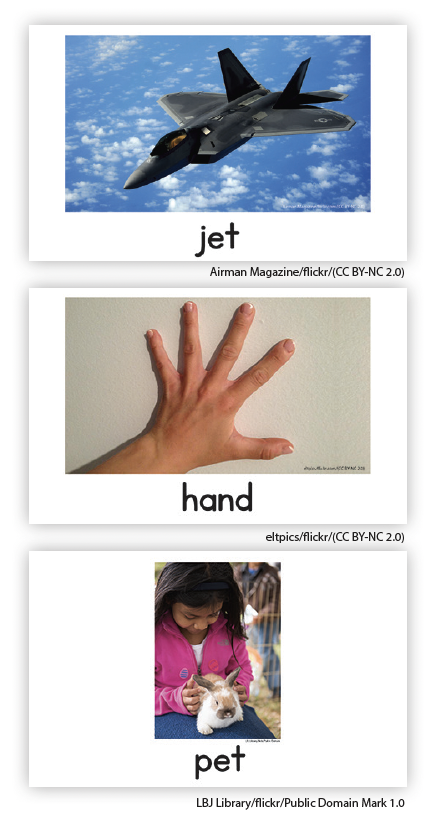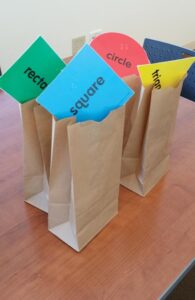Phonological awareness
Children will identify rhyming and non-rhyming words.


Review:
Be Prepared: Select the picture cards listed below. For easier use of the cards with children, glue a piece of Velcro® or felt to the back of each for placing on a flannel board. Use the following sets of picture cards:
| book-hook | bow-snow | duck-truck |
|---|---|---|
| hand-sand | jet-pet | lake-rake |
| mouse-house | rain-train | sad-mad |
| sun-run | ring-swing | pool-school |
Let’s say our nursery rhyme “Twinkle, Twinkle, Little Star” together. This time let’s say the rhyming words louder than the other words.
[Lead children in reciting “Twinkle, Twinkle, Little Star” in unison, encouraging children to use a louder voice for rhyming words.]
We are learning about words that rhyme. What do we know about words that rhyme? (they sound alike at the end)
[Display flannel board.]
Today we are going to find words that rhyme. We will place our rhyming picture cards on our flannel board.
[Place the cards “book,” “hook,” and “mouse” on the flannel board.]

We have the words “book,” “hook,” and “mouse” on our flannel board. Let’s say those words together as I point to them.
[Lead children in saying the three words aloud. Enunciate each word clearly.]
I will put our “book” and “hook” cards next to each other on our flannel board. The words “book” and “hook” rhyme. I will put the “mouse” card at the bottom of our flannel board. The word “mouse” does not rhyme with “book” and “hook.”
Now let’s say together our rhyming words as I point to them.
Let’s try another set of cards.
 [Remove the “mouse,” “book,” and “hook” cards from the flannel board. Place the cards “jet,” “hand,” and “pet” on the flannel board.]
[Remove the “mouse,” “book,” and “hook” cards from the flannel board. Place the cards “jet,” “hand,” and “pet” on the flannel board.]
We have the words “jet,” “hand,” and “pet” on our flannel board. Let’s say those words together as I point to them.
[Lead children in saying the three words aloud. Enunciate each word clearly.]
I will put our “jet” and “pet” cards next to each other on our flannel board. The words “jet” and “pet” rhyme. I will put the “hand” card at the bottom of our flannel board. The word “hand” does not rhyme with “jet” and “pet.”
Now let’s say together our rhyming words as I point to them.
[Remove the “hand,” “jet,” and “pet” cards from the flannel board. Continue placing sets of two rhyming words with an additional word that does not rhyme on the flannel board. Use the following sets of cards together as long as time and children’s interest allow:
| sun-run-lake | pool-bow-school |
|---|---|
| swing-rain-train | duck-truck-house |
Encourage children to determine which two words rhyme and which word does not rhyme.]
Today we looked at three words and decided which words rhymed and which word did not rhyme. How do we know if words rhyme with each other? (they sound alike at the end)
Extra support
Enrichment
Provide *picture cards from today’s activity and flannel board. Encourage children to match cards that rhyme.
*Printables provided
Prepare a rhyming lunch or snack. Include food items that rhyme. Examples: cheese and peas, chip and dip, potato and tomato, bean and tangerine, rice and ice (in drink), baloney and macaroni, cherry and berry, ravioli and guacamole, ham and yam, enchilada and tostada. Emphasize the rhymes as you serve the food and children enjoy their lunch or snack.
Geometric and spatial knowledge
Children will describe attributes of rectangles, triangles, circles, and squares.


Review:
Be Prepared: Place one shape in each of 12 paper bags.
We are learning about rectangles and triangles. We know that rectangles have four straight sides and their corners always look like the corners of a door. We also know that triangles have three straight sides and can have corners that are different sizes. How many corners do triangles have? (three)
Today we will do a shape activity. I have several paper bags. Each bag contains a different shape. The shape may be a triangle, rectangle, circle, or square.
[Display and point to each of the four shapes as you say its name.]
Each of us will have a chance to feel the shape in one of the bags and describe what we feel.
When you describe the shape, tell us about its sides and corners. You can tell us how many sides it has and if the sides are straight or curved. You can also tell us how many corners it has and if the corners are like the corners of a door.
I will do the first one to show you how.
 [Demonstrate by placing your hand inside a bag that contains a rectangle. Describe the rectangle as you feel it. Do not take the shape out of the bag until after children attempt to identify it.]
[Demonstrate by placing your hand inside a bag that contains a rectangle. Describe the rectangle as you feel it. Do not take the shape out of the bag until after children attempt to identify it.]
This shape has four corners that feel like the corners of a door and four straight sides. Two of the sides are long and two of the sides are short.
What shape is in the bag? How do you know?
Now we will take turns describing a shape in one of the bags!
[Begin the activity by inviting children, one at a time, to describe the shape in one of the bags. Begin with several different types of rectangles and triangles. Invite other children to guess the shape being described. As you continue, introduce bags that contain circles and squares. Continue as long as time allows, making sure each child gets at least one turn to describe a shape.]
Today each of us described a shape in a bag and the rest of the group tried to guess the shape in the bag. We described triangles, rectangles, circles, and squares.
Extra support
Enrichment
Provide children with books about shapes and encourage them to find different shapes in the books. As children find shapes, ask them to describe each shape.
Encourage all children in your setting to learn more about shapes by playing Simon Says with shapes. Provide a set of shape cutouts for each child; circle, square, triangle, and rectangle. Invite children to place their set of four shapes in front of them. Play Simon Says as you ask children to pick up a shape that has certain characteristics. Example: “Simon says pick up the shape with three straight sides and wave it in the air.” Then, encourage children to name the shape. Invite school-age children to help describe which shapes preschool-age children should pick up.
Motor development
Children will strengthen their locomotor skills for walking and marching.


New:

Be Prepared: Tape two lines on the floor in the activity space: one straight line and one line that is in a curve (approximately a half circle; see picture). Arrange for another adult (or select a volunteer child) to lead the activity so you can monitor and guide children. It is not necessary for children to walk or march in unison. Consider offering this activity outdoors, weather permitting, if inside space is limited. Omit the curve and/or walking backwards if you anticipate one or both of these aspects of the activity will be too challenging for children.
[March in place.]
What am I doing? (marching)
 Last week we practiced walking and marching. We paid attention to how our bodies move when we walk and march. Today we are going to walk and march in different directions.
Last week we practiced walking and marching. We paid attention to how our bodies move when we walk and march. Today we are going to walk and march in different directions.
Please look at the lines taped to the floor in our activity space. We will use the lines for walking and marching today.
How are the lines on the floor today different than the lines we used last week for walking and marching? (one line is not straight)
[Point to lines as you describe each.]
One line is straight, just like last week’s line. One line is a curve. The curve is like part of a circle.
Let’s practice walking on the straight line and then on the line that has a curve.
Last week we focused on how our bodies move when we walk and march. Today let’s also focus on following the lines on the floor. We will follow a leader. We will not use our “start” and “stop” signals today because each of us will be starting and stopping at a different time.
[Demonstrate and describe the path. Start walking on the straight line and then walk on the curved line. Designate an area for children to gather after they finish walking on the curved line. Encourage children to walk directly from the straight line to the curved line (not stop).
Invite a volunteer child with solid walking and marching skills to be the leader or arrange for an adult to be the leader, so you can monitor and guide children in the activity.
Invite children to start walking on the straight line in follow-the-leader fashion. Provide guidance as necessary. Remind children to pay attention to the line and to how their bodies are moving, and to keep a safe distance from the person in front of them.]
Now let’s do our walking differently. This time we will start walking on the curved line and then walk on the straight line.
[Demonstrate and describe the reverse path. Then invite children to start walking on the curved line in follow-the-leader fashion. Provide guidance as necessary. Remind children to pay attention to the line and to how their bodies are moving, and to keep a safe distance from the person in front of them.]
We need to pay attention to a line when we walk on it.
Let’s move on our lines again. This time we will march. First we will start marching on the straight line and move to the curved line. Then we will start marching on the curved line and move to the straight line.
[Demonstrate marching as a reminder, if necessary. Invite children to start marching, using a follow-the-leader arrangement. Provide guidance as necessary. Designate an area for children to gather when they complete the curved line. Children may need to wait there briefly (maybe marching in place) until the curved line is empty.]
We move toward what is in front of us when we walk forward.
[Lead children in taking several steps forward.]
Now think about the word “backward.” How do we move our body if we want to walk backward?
We move toward what is behind us when we walk backward.
[Lead children in taking several steps backward.]
We need to look over our shoulder when we walk backward.
[Demonstrate and then lead children in looking over their shoulder.]
We practiced walking and marching on a straight line and a curved line. We are learning to pay close attention to a line and to the people around us when we follow a line. We also moved forward and backward. We are practicing different ways to move.
Extra support
Enrichment
For outside play, encourage children to walk or march forward on safe, naturally occurring lines, such as lines on a sidewalk or the edge between grass and cushioned surface.
Invite a school-age child in your setting to be the leader of walking and marching activities.
Appreciating Our Families
Social Studies
Skill and Goal
Family diversity
Children will understand the concept of family.
Materials
Needed
Key
Concepts
New:
Review:
Also
Promotes
We learned a lot about ourselves in the last three weeks. We know each of us is unique. This week we will learn about how our families are also unique. Do you remember what unique means? (there is no other person just like you)
Each of our families is unique. Some of us have brothers and sisters, and some of us do not. We may live with our parents, grandparents, or someone else in our family. A family is a group of people. Some of our family members may live far away and some may live near us or with us.
Who are some people in your family?
Let’s pretend we are popcorn when I describe some people who may be in your family. Remember, popcorn pops when it is being made. We can pretend we are popcorn by popping up (standing up) when I ask about people who may be in your family.
[Invite children to pop up after you name the following family members that may be in their family. Ask children to sit down after you have commented on the number of children who have each kind of family member in their family.]
We are going to read a book about families. It is called Families, Families, Families! The book tells us about the many different people who can be in a family. The authors of this book are Suzanne and Max Lang.
[Describe illustrations as you read the book. Pause to talk about pages that seem confusing to children.]
Today we talked about our families. Some of our family members live with us and some live near or far away. We also read a book about families. Our families can be the same and different but no two families are exactly alike!
Scaffolding Tips
Extra support
Enrichment
Center Activity
Provide the book used in today’s activity. Encourage children to discuss how the families in the book are the same and different. As children share how the families are the same and different, ask them how the families in the book are the same or different from their own families.
Family Child Care
Encourage children in your setting to share more about their families by playing a game. Arrange preschool-age and school-age children in a circle. Invite each child, one at a time, to finish the sentence “My family is _____.” After each child has finished the sentence, encourage children to go around the circle again and finish a different sentence. Examples: “My family likes _____.” “My family has _____.” My family wears _____.” School-age children may enjoy acting out some of the family descriptions. Example: If a child finishes the sentence “My family likes _____” with “to go fishing” invite the child to pretend to go fishing with his/her family.